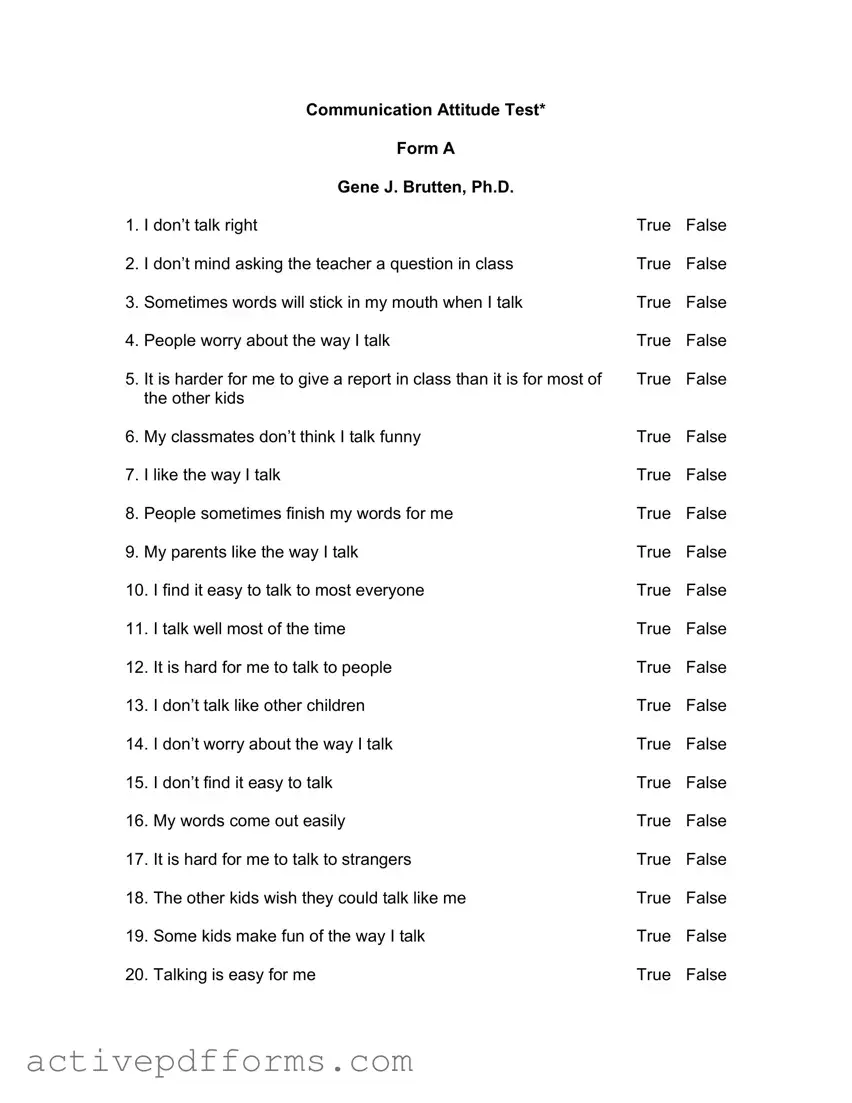What is the Communication Attitude Test A form?
The Communication Attitude Test A form, also known as the CAT-A, is a self-reporting tool developed by Gene J. Brutten, Ph.D., designed to assess the feelings and attitudes individuals have towards their own speech. This tool is particularly useful in identifying speech-related concerns, such as stuttering, in children and adults.
Who should take the Communication Attitude Test A form?
The CAT-A is primarily aimed at individuals who may have concerns or issues with their speech, including those who stutter. However, it can be used for a broader audience to assess general attitudes toward communication. Teachers, speech therapists, and psychologists often administer this test to diagnose speech issues or to evaluate the effectiveness of ongoing speech therapy.
How is the test administered?
The test consists of 35 statements related to the individual's feelings and attitudes towards speaking. The individual indicates whether each statement is 'True' or 'False' as it applies to them. It can be administered in a clinical setting by a professional or used as a self-assessment tool. The simplicity of the test format makes it accessible to a wide range of ages and abilities.
What kind of questions are included in the CAT-A?
Questions in the CAT-A range from personal perceptions of speech ('I don’t talk right') to interactions with others ('People sometimes finish my words for me'). They aim to capture the individual's confidence, anxiety, and experiences related to speaking in both public and private settings.
How are the results interpreted?
Results are interpreted based on the number of 'True' responses, with a higher number indicating a more negative attitude towards one's own communication abilities. However, interpretation should be conducted by professionals who can consider the context of each response and integrate these findings with other assessments or observations.
Can the CAT-A diagnose speech disorders?
No, the CAT-A cannot diagnose speech disorders on its own. It's a tool designed to assess attitudes towards communication, which can be an important component of a comprehensive diagnostic evaluation. Diagnosis of speech disorders requires a multifaceted approach, including clinical evaluation by a speech-language pathologist.
Is the Communication Attitude Test A form suitable for all ages?
While the test is straightforward, it requires the respondent to read and understand each statement fully and reflect on their own experiences. Thus, it is generally suitable for children who have reached a sufficient level of reading comprehension and self-awareness, typically around the age of 7 and older, up to adults.
How often should the CAT-A be administered?
The frequency of administration depends on the individual's circumstances and the goals of assessment. In a therapeutic context, it might be administered at the beginning and end of a therapy program to measure changes in attitude towards communication. Yearly reassessment can also be helpful in tracking changes over time.
What should I do if the test indicates a negative attitude towards communication?
If the test results suggest a negative attitude towards communication, it might be beneficial to consult with a speech-language pathologist or a psychologist. They can provide a comprehensive evaluation, offer support, and, if necessary, recommend a course of treatment, such as speech therapy, counseling, or participation in support groups.
Is there a cost to take the CAT-A?
The availability and cost of administering the CAT-A can vary. In many clinical or educational settings, the test may be provided as part of a service to clients or students at no additional charge. However, if a professional, like a private speech-language pathologist, administers the test outside of such settings, there may be a fee involved. It's advisable to inquire about any potential costs upfront.
